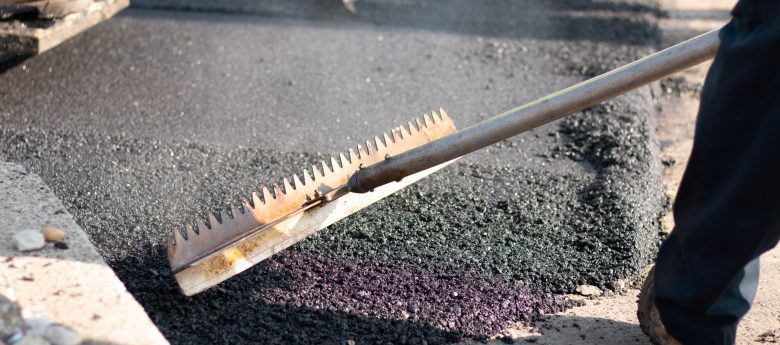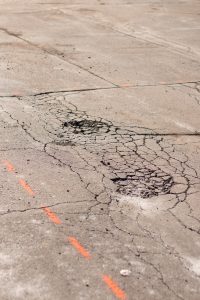Post-Winter Parking Lot Repairs

The winter season brought damaging weather and precipitation for roads, sidewalks, and – importantly for facility managers – parking lots. With the cold weather and snow behind us and spring now in full effect, it’s time for facility managers to evaluate their parking lots for any defects in need of repair. While seemingly minor problems like cracks and holes might not seem serious, they can quickly deteriorate and endanger the safety of employees and guests.
To keep everyone safe, managers need to assess their parking lots carefully and as soon as they are able. If any defects have popped up during the winter, they should work with a professional to take action on any needed repairs. Even if the cracks or holes seem minor, it’s a good idea to get the perspective of an experienced trade professional like a paving and sealcoating specialist. They will be able to help show managers what to look for and what small issues will become bigger expenses if not immediately repaired. They can also help determine if making repairs and maintaining the lot will work, or if a complete overhaul will be necessary now or in the future.
When evaluating your lot, look out for these common defects that pop up in the winter:
- Potholes
Potholes are the most common parking lot problem, and they are aggravated by the colder temperatures and increased precipitation that occur in the winter. Even if the temperature wasn’t consistently very cold or not much snow fell, winter is still hard on the pavement. In fact, what many people may not realize is that the worst kind of weather for pavement is cold nights followed by warmer days. This constant change in temperature causes the asphalt to fluctuate between freezing and thawing, which causes it to move and deteriorate much more quickly, resulting in cracks and potholes.
- Failed Catch Basins
It’s common for catch basins – the drainage structures that collect water and transport it underground – to fail and need repair in the spring. Whether it’s from the expanding and shrinking that comes with temperature fluctuation and precipitation, or they are hit by snowplows, catch basins are often damaged during the winter.
- Cracks and Corrosion
Cracks, small holes, and corrosion have likely gotten worse during the winter months. While these smaller issues may seem harmless, they can deteriorate very quickly once they’ve sprung up, so it’s important to keep a watchful eye and try to repair them before they become a bigger issue. This will help prevent a bigger, more expensive repair or replacement down the road.

Unfortunately, these defects in parking lots aren’t just an eyesore – if not treated properly, they can cause unsafe driving conditions for customers and employees and increase the risk of people tripping. To avoid potholes, drivers often swerve out of their lane, which can cause fender benders or even result in pedestrian injuries.
Importantly, outdoor walkways and parking lots also have to be maintained to a certain level for public access, in accordance with the city code in which the facility is operating. If the space becomes dangerous for consumers, businesses can receive warnings or even fines from the city until they are fixed. Managers are liable for damage or injuries and should always try to stay ahead of a reprimand by keeping their lots in great shape.
To avoid these dangerous, expensive, and preventable liabilities, here are a few tips that management should keep in mind:
- Fill cracks and holes in a parking lot immediately. Cracks and holes need to be filled as soon as they start developing so they don’t expand with fluctuating temperatures and increased precipitation. This avoidable and common problem leads to trip hazards and can even damage cars.
- Avoid using gravel or stone to fill in potholes. Gravel or stone aren’t recommended because they quickly loosen and spread out around the pothole. If a property manager can’t immediately work with a professional to get hot mixed asphalt, asphalt cold patch can be used as a temporary fix.
- Mark the potholes and large cracks with traffic cones. If permanent repairs can’t be made immediately, mark the area with cones. This will ensure that people walking and driving their cars see – and avoid – the pothole or large crack.
When in doubt, it’s always best to get a professional opinion about what action needs to be taken, preferably before potholes cause expensive damage or injury. Facility managers already have enough on their plates without adding a customer injury or vehicle damage to the list. And the last thing any business wants is for an employee or guest to fall and injure themselves, especially when a simple fix could have prevented the headache for everyone. In the end, it will be worth setting up an appointment to ensure their staff and guests are safe.
Bob Lester is president and CEO of Dura-Seal, a sealcoating, asphalt, and concrete services company. He has worked in the paving industry for over 20 years, leading two buyouts, an acquisition, and the sale of an equipment manufacturing company at Dura-Seal. Prior to joining the company, Bob studied business finance at Otterbein University. He can be reached at sales@durasealohio.com.
